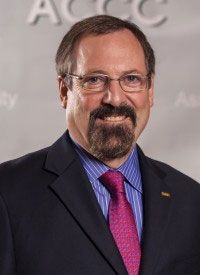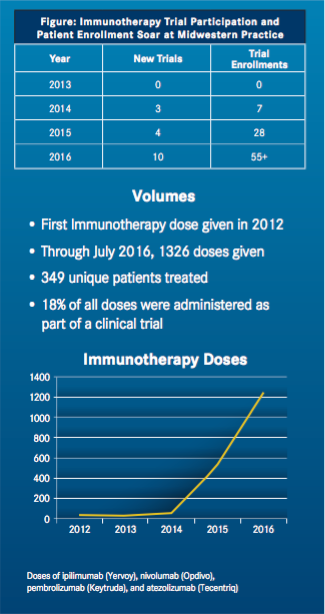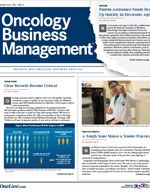Longer Hours Were Too Much for Them
Staff attrition generally does not come in the size and shape it did for a small New England practice that constitutes the last independent oncology practice in Maine.
Steven D’Amato, BSPharm

Steven D’Amato, BSPharm
Staff attrition generally does not come in the size and shape it did for a small New England practice that constitutes the last independent oncology practice in Maine. It happened when the clinic switched over to the Come Home model of coordinated care that emphasizes patient access. The group, New England Cancer Specialists, lost 50 workers to the transition. The demands of adapting to new schedules and ways of doing things were simply too much for the workers.
“When you have a practice that’s 35 years old and employees have never worked weekends or extended hours, when you change that model, obviously you’re going to lose some personnel,” said Steven D’Amato, BSPharm, executive director. He said a senior manager with two decades in the practice had to be let go because she wouldn’t embrace the vision of Come Home. Another bumpy ride may be in store for D’Amato’s practice of 15 physicians and 12 nurse practitioners and physician assistants. They are now deeply invested in the Oncology Care Model experiment, which D’Amato describes as “the Come Home model on steroids.”
The difficulties of adjusting to new value-based systems in the age of immuno-oncology were discussed by a panel of three oncology executives at the national conference of the Institute for Clinical Immuno-Oncology, held in Philadelphia in October. The discussion ranged over many issues related to the financial side of managing practices. Keeping drugs stocked at in-house pharmacies is a huge expense that is getting bigger, thanks to newer, more expensive medications, the speakers said. They foresee the cost barrier rising higher as combination therapies in immuno-oncology begin to proliferate. Not enough data exists for professionals to understand the nancial implications of these therapies, they said. In addition, staff training has gotten much more important as the pace of discovery rapidly outdates much of what physicians and other practice members need to know to stay in the forefront of treatment. Furthermore, meeting the need for patient access to care has necessitated the hiring of additional staff on all levels, the panelists said.
One essential part of patient access is offering the same clinical trial enrollments as urban centers are able to do, the speakers said. At the Dickstein Cancer Center in White Plains, New York, clinical trial participation has been ramped up with the aid of an af liation with an academic institution, said center administrator Una Hopkins, DNP. “Most pharmaceutical companies do not like to go to community settings because they don’t feel like they get enough bang for their buck with respect to the amount of patients going on clinical trials,” Hopkins said. The academic affiliation not only made it possible for Dickstein to become more of a player in trial therapies but also helped out patients considerably by alleviating the need for them to travel to urban centers for experimental-but-promising treatments. “When I started in my community center five years ago, we had two patients on two clinical trials, and now we have 21 open clinical trials. We have 753 patients on clinical trials,” Hopkins said. Part of the challenge is finding clinical trials that match the needs of the patient population that the clinic serves, Hopkins said.
Technology Removed Barriers to Care
Problems continue with IT applications that won’t communicate with competing brands. It doesn’t help that the demands on IT are greater than they have ever been, as record-keeping requirements have increased and CMS has introduced models of care that require much greater tracking and reporting of patient progress, said D’Amato. The added costs for incremental improvements in software capability add up to a huge financial burden. “Our IT vendors need to help us more. Right now, I feel like I’m being nickel-and-dimed to death for every single little thing that we want to do as a practice. Interfaces aren’t cheap, but we need interfaces with other software programs that are going to support our practices and institutions.” Hopkins described some of the access barriers between software applications as “completely unethical.”But there’s one kind of technology that has removed barriers to care, and this was described by Sharon Hunt, MBA, CMPE, executive director of oncology at Sanford Health, whose operations in the Dakotas and Minnesota cover a rural area bigger than Texas. Out there, distances between patients and clinics are oftentimes immense, and the introduction of telemedicine has enabled physicians and advanced practitioners to supervise care administered in remote locations. “Our average population density is less than 8 per square mile, so we have to travel a long way to see our patients, and our patients have to travel a long way to see us. We have one gynecological oncologist for our entire system, so that doctor gets on a plane and travels to Fargo and to Bismark at least once or twice a month.”
What’s exciting about the telemedicine revolution in oncology is that even clinical trial access has improved, Hunt said. “We petitioned the Gynecology Oncology Group and were able to get them to approve telemedicine for those clinical trials, so [our GynOnc] can go there and put the patient on the clinical trial, but then the follow-up visits can happen via telemedicine, which was huge for our patients. Otherwise, we ended up with women who just couldn’t possibly go on a clinical trial.” (Figure)
With the rise of immuno-oncologic therapies, the need for ongoing staff training has become critical to success, the panelists said. Changes from measured doses to at dosing create questions of when it is best to switch a patient to a new formulation, but also the rise of combination therapies promises to add a whole new layer of complexity to the business and practice of oncology, D’Amato said. Patients need educating, too, and hiring more staff has been the solution at Sanford, Hunt explained. The number of pharmacists at Sanford has been raised from 1.5 to 5 so that they can do the needed amount of calling to patients to make sure they are properly informed about the drugs they are taking and when they need to come in and see the oncologist. “We took a pharmacy tech and sent her back to school, and she is now our patient advocate and our preauthorization guru, and that has just been huge for us. She understood the drugs from the get-go, has a great relationship with the pharmacists, knows all of the medical oncologists, and is really able to be that liaison and get us good preauthorization.”
Figure

Training builds professional confidence and fosters a strong team environment, Hunt said. “The training and education that your nursing staff needs to be able to not only triage but know when to bring people in and to feel comfortable giving those doses is huge, so what we have done is, twice a month we now have nursing education, and we give [continuing education units] for them. It also is a way for our medical oncologists to really interact with our nursing staff. And so they’re the ones that give the education seminars. And we go over What’s a reaction like? What does it look like? What questions do you ask those patients over the phone to get them in here when they need to come? We also have two palliative care physicians that are embedded in our medical oncology clinic, and we have a social worker.”
New therapies are bringing with them higher prices, and D’Amato’s experience has been that pharma companies have been generous through patient advocacy groups in providing funds and drugs that patients otherwise could not afford. That type of assistance doesn’t close the gap completely, nor does it resolve the problem of rising prices. It also does not answer the need to link drug pricing with efficacy, he said. “I think there needs to be vetting of information. We need key opinion leaders in various areas to make sure that the assumptions made are true and backed with evidence.” A related problem is the widespread demand for patient assistance and how sources of this funding “dry up quickly or are nonexistent for some of the drugs now,” D’Amato said.




